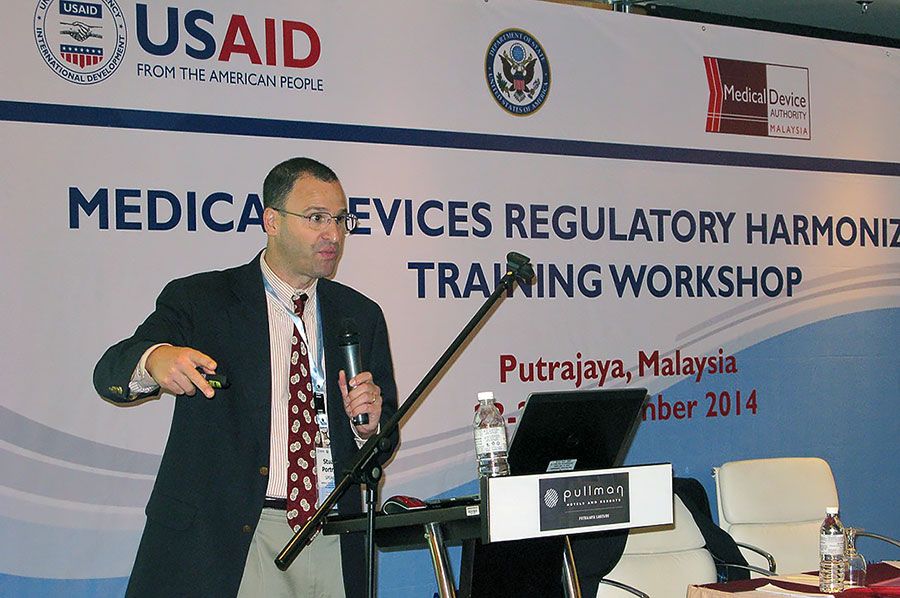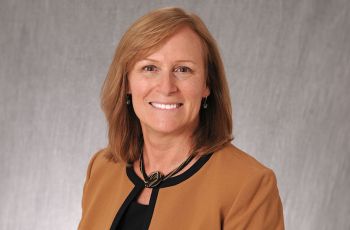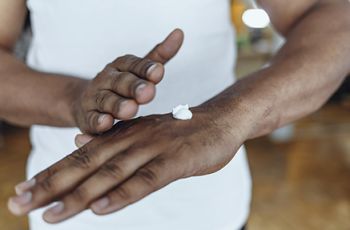
Stuart Portnoy, M.D. ’91, RESD '92, has just returned from a trip to Germany and Austria with his family. His itinerary is colorful and neatly laid out in a document on his laptop, though he clicks from it to other items, including a map of another trip, this one to Vietnam in April. The September before he was in Malaysia, and a year before that his destination was Singapore. This latest passage abroad was personal; the others, business.
“It’s so much fun for me to be there [in Southeast Asia],” Portnoy says, “and I love traveling.”
Although his trips are recent, the story behind them stretches back years. Portnoy’s journeys first began as a young student. “From the time I was at GW medical school — I’d already studied chemical engineering as an undergraduate — I knew during year one that I wanted to do something at the intersection of medicine and technology,” he says.
Portnoy was always a techie. He preferred Scientific American over his classmates’ favorite, the New England Journal of Medicine, and while he loved interacting with patients, he was drawn more to the medical devices. So when he was accepted to the GW School of Medicine and Health Sciences, he wrote the school a letter, asking to delay his education for one year to continue exploring.
“I said, ‘I’m so burnt out. I just did four years of chemical engineering. I want to go to Israel and do biomedical engineering over there,’” Portnoy recalls. “The director of admissions said, ‘We do not want you to start until you believe you’re ready.’ It was so refreshing. ‘You go and do your thing and come back a year later.’ And I did. When I was in Israel, I worked on a really great biomedical engineering project, and it solidified my interest. I knew by the end of that year that I wasn’t going to be a traditional physician.”
When Portnoy returned to the United States, he settled into the GW environment, but later took another year-long break, this time to earn a master of science degree in bioengineering at the University of Pennsylvania. “I loved it so much,” he says.
As both an M.D. and an engineer, Portnoy took what he classifies as a “unique career path.” He spent eight years with the Food and Drug Administration (FDA) before turning to consulting with Biologics Consulting Group. His area of expertise is medical device regulation for cardiology-specific instruments. With his extensive clinical and FDA-based regulatory background, Portnoy became an appealing candidate for the missions that would take him overseas. That story begins about two decades ago.
During the 1990s, according to Matthew Hein, international trade specialist for the U.S. Department of Commerce’s International Trade Administration (ITA), a group called the Global Harmonization Task Force (GHTF), which included the European Union, Canada, Australia, Japan, and the United States, put together guidance documents for the ways medical device regimes should function. The goal was to zero in on the common and best practices existing between the different nations. Southeast Asia was quickly identified as one of the places that would best benefit from the GHTF’s guidance documents, and Singapore became the first volunteer to begin implementing medical device regulatory regimes.
Fast forward a few years, and the Association of Southeast Asian Nations (ASEAN), which includes Singapore, was contemplating how best to implement GHTF-based regulatory regimes in the other ASEAN Member States (AMS). The AMS began developing the ASEAN Medical Device Directive, which outlines the principles, concepts, and guidelines for implementation, and after obtaining support from the AMS regulators of the ASEAN Medical Device Product Working Group, ITA offered to organize training. That training, a series of workshops based on the GHTF guidance documents, is where Portnoy comes in. He received word that ASEAN was looking for “FDA alumni” to instruct at the workshops, and he jumped at the opportunity. “It’s a perfect partnership between people like me, an FDA alum, and what the Department of Commerce and the host nations are looking for,” Portnoy says.
After visiting Singapore in 2013 to consult about his experience with the FDA, Portnoy later joined the ITA initiative. As one of several industry trainers, he went to Malaysia and Vietnam in 2014 and 2015, respectively, to present at medical device regulatory workshops. In Vietnam, Portnoy spoke about clinical evidence, though the learning and valuable interactions, he says, went both ways.
“I think the best part is spending time with my peer group,” Portnoy says. “People who I didn’t know before that I really love to talk shop with, talk professional, talk families, talk about what companies they’ve worked at before. That’s one. Number two, I am learning. I am learning new things all the time, which is great for me. It’s great for a consultant to be expanding my knowledge base into areas that I typically wouldn’t be involved with.”
Portnoy intends to return to Southeast Asia, where he’s enthusiastic about the regulatory regime developments.
“It’s a win-win-win, no matter how you look at it,” Portnoy says. “I just love it from start to finish.”


